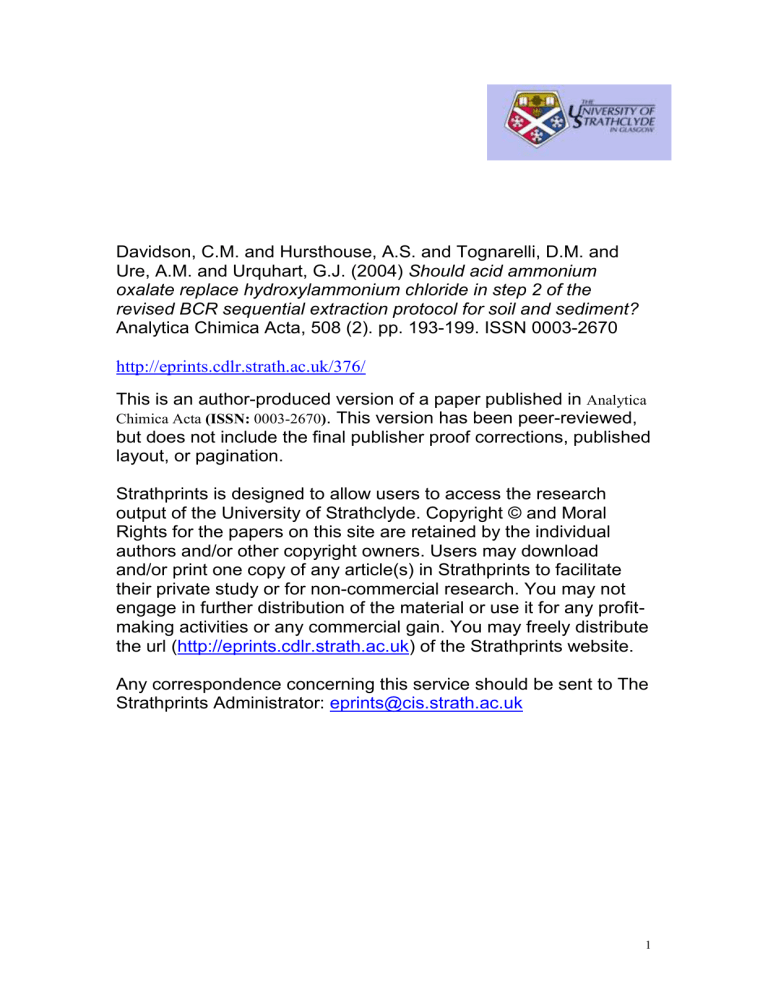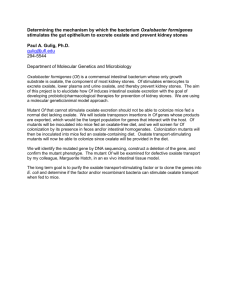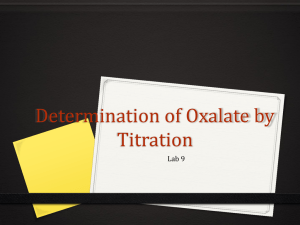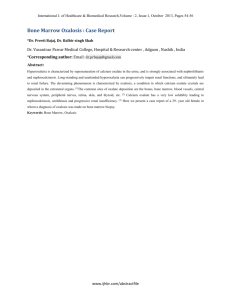strathprints000376 - You have reached the Pure environment

Davidson, C.M. and Hursthouse, A.S. and Tognarelli, D.M. and
Ure, A.M. and Urquhart, G.J. (2004)
Should acid ammonium oxalate replace hydroxylammonium chloride in step 2 of the revised BCR sequential extraction protocol for soil and sediment?
Analytica Chimica Acta, 508 (2). pp. 193-199. ISSN 0003-2670
http://eprints.cdlr.strath.ac.uk/376/
This is an author-produced version of a paper published in Analytica
Chimica Acta (ISSN: 0003-2670 ) . This version has been peer-reviewed, but does not include the final publisher proof corrections, published layout, or pagination.
Strathprints is designed to allow users to access the research output of the University of Strathclyde. Copyright © and Moral
Rights for the papers on this site are retained by the individual authors and/or other copyright owners. Users may download and/or print one copy of any article(s) in Strathprints to facilitate their private study or for non-commercial research. You may not engage in further distribution of the material or use it for any profitmaking activities or any commercial gain. You may freely distribute the url (
http://eprints.cdlr.strath.ac.uk
) of the Strathprints website.
Any correspondence concerning this service should be sent to The
Strathprints Administrator:
eprints@cis.strath.ac.uk
1
Should acid ammonium oxalate replace hydroxylammonium chloride in step 2 of the revised BCR sequential extraction protocol for soil and sediment?
Christine M. Davidson a*
, Andrew S. Hursthouse b
, Donna M Tognarelli b
, Allan M
Ure a
and Graham J. Urquhart a
. a Department of Pure and Applied Chemistry, University of Strathclyde, 295 Cathedral Street,
GLASGOW G1 1XL, UK b School of Engineering and Science, University of Paisley, High Street, PAISLEY PA1 2BE, UK
The revised, four-step BCR sequential extraction for soil or sediment has been compared with an alternative procedure in which 0.2 mol l
-1
ammonium oxalate (pH
3) replaced 0.5 mol l
-1
hydroxylammonium chloride (pH 1.5) in step 2, the reducible step. A variety of substrates were studied : BCR CRM601, a sewage sludge amended soil, two industrial soils, and a steel manufacturing by-product (basic oxygen furnace filter cake). Greater amounts of iron were recovered in step 2 when acid ammonium oxalate was used, for all substrates. Similar trends were observed for copper.
Manganese and zinc were not strongly affected by the procedural modification, except for zinc in the two industrial soils, where oxalate extraction proved more efficient than use of hydroxylammonium chloride. A large proportion of the calcium and lead isolated in step 2 of the BCR procedure was not released until step 3 when the alternative procedure with oxalate in step 2 was used. This is probably due to rapid precipitation of analyte oxalates from solution. Thus, whilst oxalate offers superior dissolution of iron-containing matrix components, it should not be used if calcium or lead concentrations are to be measured. Selection of the most appropriated sequential extraction protocol for use in a particular study must always be carried out on the basis of “fitness for purpose” criteria. However, the revised BCR protocol, involving use of 0.5 mol l
-1
NH
2
OH.HCl in the reducible step, appears to be more generally applicable than procedures involving acid ammonium oxalate.
* corresponding author: c.m.davidson@strath.ac.uk
2
Introduction
Sequential extraction is widely used for fractionation of the trace elements in soil, sediment and waste materials [1]. The sample is treated with a series of extractants selected on the basis of their ability to release analytes bound to different components of the matrix. Unfortunately, the reagents used are rarely entirely phase-specific and analytes released by a particular extractant may be re-adsorbed or precipitated before they can be isolated for analysis [2,3]. Hence, the approach gives operational information on potential trace element mobilities under different conditions.
Many extraction protocols exist. However, one of the more popular is the three-step procedure developed under the auspices of the Community Bureau of
Reference, Commission of the European Community [4]. The original BCR protocol involves successive treatment of the sample with 0.11 mol L
-1
acetic acid, 0.10 mol L
-
1
hydroxylammonium chloride at pH 2, and hydrogen peroxide followed by 1.0 mol
L
-1
ammonium acetate at pH 2. The fractions obtained are termed “exchangeable”,
“reducible” and “oxidisable”, respectively. A reference material (BCR CRM 601) has been prepared with certified contents of five trace elements extractable by the BCR scheme [5].
Unacceptable variability in results obtained for the reducible fraction during certification of CRM 601 led, eventually, to a thorough re-evaluation of the extraction protocol [6]. Several modifications were proposed [7]. Most importantly, it was recommended that the NH
2
OH.HCl concentration be increased to 0.5 mol L
-1
and the pH of the extractant decreased to pH 1.5. A fourth step (aqua regia extraction) was also introduced. This meant that the total amount of metal extracted by the sequential procedure (
steps 1-4) could be compared with results of a separate aqua regia digestion to provide some degree of procedural validation. The revised BCR sequential extraction has been applied to a number of certified reference materials
(sediment BCR CRM 601 [8, 9]; soils BCR CRM 483 [10], SRM 2710 [9] and SRM
2711 [9], and road dust CW 7 [9]) in order to provide indicative values for validation of future studies.
Soil scientists have, for many years, used acid ammonium oxalate to estimate the amount of amorphous iron oxides in soil [11]. Many sequential extraction protocols incorporate an oxalate extraction step to target specifically these reducible
3
soil components. However, when Benitez and Dubois compared three, six-step sequential extractions, involving various combinations of hydroxylammonium chloride and oxalate, they found that recoveries depended markedly on the solubility of analyte-oxalate species [12]. Preliminary work conducted under the auspices of
BCR also suggested that oxalate-containing extractants should not be used in sequential extraction if analytes, such as lead, which readily form insoluble oxalate precipitates, were to be determined [6].
The aim of the present work was to assess critically the usefulness of acid ammonium oxalate as a replacement for hydroxylammonium chloride in step 2 of the
BCR protocol. A range of substrates was studied: sediment BCR CRM 601, a sewagesludge amended soil, two industrial soils with different pollutant loads and one steelmaking by-product (basic oxygen furnace filter cake). The industrial samples were included for two reasons. They were potentially rich in iron oxides, hence oxalate extraction might be expected to be more appropriate than use of NH
2
OH.HCl. Also, they represented challenging matrices for application of sequential extraction, especially the filter cake, which is both refractory and strongly alkaline.
Experimental
Apparatus
Extracts and digests were analysed by atomic spectrometry. The instruments used were a PU 9100 flame atomic absorption spectrometer (Thermo Electron, Cambridge,
UK), a PU 9390 electrothermal atomic absorption spectrometry (also from Thermo
Electron) and a PE Optima 3000 inductively-coupled plasma atomic emission spectrometer (Perkin Elmer, Norwalk, Connecticut, USA). Analytes were analysed with respect to reagent-matched standard solutions. Single element standards were used for AAS and multi-element standards for AES.
Reagents
Nitric, hydrochloric and acetic acids were AR grade, supplied by Aldrich
(Gillingham, UK). Hydrogen peroxide was “For Analysis” grade, obtained from
Fisher Scientific (Manchester, UK). Ammonium acetate, ammonium oxalate, oxalic acid and hydroxylammonium chloride were AnalaR® reagents from Merck (Poole,
4
UK). Calibrant solutions were prepared by serial dilution of 1000
g ml -1 Spectrosol standards, also from Merck, with sequential extraction reagents. Samples are described in Table 1.
Procedures
The revised BCR sequential extraction was carried out as described in reference 7, except that 0.2 mol L -1 ammonium oxalate (pH 3) was sometimes used instead of 0.5 mol L
-1
hydroxylammonium chloride (pH 1.5) in step 2. A brief description of the experimental procedures is given in Table 2. Whenever an oxalate extraction was performed, the centrifuge tubes were wrapped with aluminium foil to exclude light and prevent attack on more crystalline iron oxyhydroxides [11]. In order to eliminate sources of variability, the same substrate was extracted simultaneously by means of the two alternative procedures i.e. each batch of extractions involved replicate specimens and one blank undergoing the BCR procedure, together with replicate specimens and one blank undergoing the oxalate variant.
Aqua regia digestion was performed with microwave assistance, using either a MDS
2000 system or a Mars X (both CEM Corporation, NC, USA).
Results and discussion
Pseudototal metal contents
The pseudototal (aqua regia soluble) metal contents of the substrates studied are shown in Table 3. Results obtained for copper and lead in the present study are statistically similar to literature values but less zinc was recovered than expected. The sewage sludge amended soil contains copper, lead and zinc at potentially phytotoxic levels. The two industrial soils are very different from each other, despite being collected only a few metres apart. This illustrates the marked heterogeneity that can occur in soil from recently-derelict industrial sites. AR1 contains levels of analytes close to typical soil ranges, whilst AR2, which was characterised by a pronounced reddish colour and supported no surface vegetation, contains little calcium,
5
moderately high levels of copper and zinc, and extremely high concentrations of iron and lead.
Extraction of CRM 601
Indicative values are available for the amounts of copper, lead and zinc that can be recovered from CRM 601 by means of the revised BCR extraction protocol [8]. These were comparable with results obtained in the present work for all steps (Table 4).
Comparison of sequential extractions procedures
The average percentage recoveries obtained with the revised BCR protocol and the modified protocol involving ammonium oxalate, with respect to pseudototal values, are presented in Table 5. Both protocols extracted more calcium from the samples, except for GTB soil, than did aqua regia digestion. Few sequential extraction results for this element have been previously reported and further investigation is required to determine the reason for the discrepancy obtained. The sequential extraction involving oxalate recovered greater amounts of copper from the soils, but not from sediment or filter cake, than the modified BCR protocol. The average iron recovery was close to 100 % with both procedures, but there was considerable variation between substrates (recoveries from 81-113 % for BCR and 72- 107 % for the oxalate procedure). Manganese recoveries were 100 ± 10 %, except for CRM 601. Lead recoveries were also essentially quantitative for the sediment and soils, but much larger amounts were recovered from the filter cake, using either sequential extraction, than were released by aqua regia. Zinc recoveries were broadly acceptable (aqua regia value ± 15 %) when the revised BCR scheme was applied, but were significantly enhanced when the industrial soils were subjected to the procedure involving oxalate
As might be expected, a greater number of discrepancies between the sequential extraction results (
(steps 1-4)) and pseudototal values occurred for the more challenging substrates (AR2 and, to a lesser extent, AR1 and BOF). However, the overall mean analyte recovery by means of the BCR sequential extraction was 111 ±
25 %, which more closely corresponds to aqua regia extractable metal contents than does the oxalate variant (mean recovery 123 ± 25 %).
6
When hydroxylammonium chloride is replaced with ammonium oxalate the effect on trace element partitioning varies between analytes. A greater amount of iron is extracted in step 2 when ammonium oxalate is used in place of hydroxylammonium chloride (Figure 1) for all substrates studied except the BOF filter cake. Oxalate appears to be able to liberate iron from mineralogical phases that, under the BCR scheme, would be classed as part of the residual fraction. In contrast, filter cake showed an enhancement in iron in step 3 when the oxalate procedure was used.
Generally similar trends to iron were observed for copper. A particularly large increase in copper recovery was noted in the reducible phase for AR2 when the oxalate extractant was used. This additional copper originates in a reservoir that is entirely inaccessible to the BCR procedure.
Manganese recoveries by the two procedures were similar (Figure 2). No enhancement with use of oxalate was expected since even relatively short exposure to dilute hydroxylammonium chloride has been shown to dissolve manganese oxides efficiently [15]. Zinc partitioning was also, generally, less strongly affected by the alteration in the step 2 reagents than the majority of the other analytes, except for AR1 and AR2. For these substrates, ammonium oxalate removed more zinc than hydroxylammonium chloride. A greater amount of zinc was found in the oxidisable phase when AR1 had been treated with oxalate. This may, however, be an artefact caused by poor precision obtained for analysis of the Step 3 extract of this particular substrate (RSD = 70%, n = 3, for the procedure involving oxalate).
RSD values for sequential extractions were otherwise generally acceptable (< 15 % for the industrial materials and < 10 % for CRM and GTB, reflecting the higher heterogeneity of the industrial substrates).
Calcium and lead behaved similarly to each other but differently from the other analytes (Figure 3). Calcium is mainly associated with step 1 in many of the substrates, which is expected since acetic acid is intended to target the carbonate phase, likely to be dominantly CaCO
3
. However, a large proportion of both calcium and lead found in the reducible fraction using the BCR protocol was retained until step 3 when ammonium oxalate was used in step 2.
7
The reason the use of oxalate affects different trace elements in different ways is due to a combination of factors. These include (a) relative solubility products of metal oxalates (Zn>Pb>Cu [16]), (b) relative stability constants of metal-oxalate complexes
(Cu>Zn>Pb [12]), and (c) amounts of analyte present in extracts. The relatively low solubility of lead oxalate means that any released from the reducible phase would react rapidly with oxalate anion and precipitate from solution. Calcium oxalate is approximately three times more soluble than lead oxalate (solubility product 2.34 x
10 -9 mol l -1 vs.
8.51 x 10 -10 mol l -1 [16]) but the higher amounts of calcium present mean that it too will precipitate. Hence, these elements are retained in the residue at the end of step 2 and not recovered until after peroxide treatment in step 3. Although copper and zinc oxalates also have low solubility products, the higher stability of the complexes means that they remain in solution. The greater amounts of copper liberated in step 2 of the sequential extraction incorporating oxalate may indicate that this element is associated with iron in the solid phase. Alternatively, as has previously been suggested [12] this may represent an over-estimation of the reducible fraction caused by the relative ease of copper oxalate complex formation.
Conclusion
Acid ammonium oxalate provides a more complete dissolution of the iron-containing phases of the substrates studied than does hydroxylamine hydrochloride. However, for certain analytes, the low solubility of the metal oxalates may lead to poor recoveries in step 2 of the sequential extraction. Selection of a sequential extraction method should be carried out on the basis of “fitness for purpose” within the context of a particular study. Oxalate would therefore appear to be the preferred reagent where iron is the principle analyte and elements such as copper and lead are not of interest.
For general purposes, however, it is recommended that the use of hydroxylammonium chloride be continued.
Acknowledgements
DMT acknowledges the financial support of CORUS (UK) and the University of
Paisley. GU acknowledges the financial support of the European Commission 5 th
Framework Programme via contract EVK4-CT-2001-00053. The authors are also
8
grateful to Robert Crawford and Janet Harris (ICI Nobel Enterprises) for provision of industrial soil samples.
References
1.
M. Kersten, Speciation of trace metals in sediments in : A.M Ure, C.M.
Davidson (Eds.), Chemical Speciation in the Environment (2 nd
Edn),
Blackwell, Oxford, 2002.
2.
T. Qiang, S. Xiao-quan and N. Zhe-ming, Sci. Total Environ. 151 (1994) 159.
3.
P.P Coetzee, K. Gouws, S. Plüddemann. M. Yacoby, S. Howell, L. den
Drijver, Water SA 21 (1995) 51.
4.
A.M. Ure, Ph. Quevauviller, H. Muntau, B. Griepink, Int. J. Environ. Anal.
Chem. 51 (1993) 135.
5.
Ph. Quevauviller, G. Rauret, J.F López-Sànchez, R. Rubio, A Ure, H Muntau,
Sci. Total. Environ., 205 (1997) 223.
6.
A. Sahuquillo, J.F. López-Sànchez, R. Rubio, G. Rauret, R.P. Thomas, C.M.
Davidson, A.M. Ure, Anal. Chim. Acta 382 (1999) 317.
7.
G. Rauret, J.F. López-Sànchez, A. Sahuquillo, R. Rubio, C. Davidson, A.M.
Ure, Ph. Quevauviller, J. Environ. Monit. 1 (1999) 57.
8.
G. Rauret, J F López-Sànchez, A Sahuquillo, H Muntau and Ph. Quevauviller,
Indicative values for extractable contents (mass fractions) of Cd, Cr, Cu, Ni,
Pb and Zn in sediment (CRM 601) following the modified BCR-sequential extraction (three step) procedure, Report EUR 19502 EN, European
Commission, Brussels, 2000.
9.
R. A. Sutherland and F M G Tack, Anal. Chim. Acta, 454 (2002) 249.
10.
G. Rauret, J.F. López-Sànchez, A. Sahuquillo, E. Barahona, M. Lachica, A.M.
Ure, C. M. Davidson, A. Gomez, D. Lück, J. Bacon, M. Yli-Halla, H. Muntau,
Ph. Quevauviller, J. Environ. Monit. 2 (2000) 228.
11.
B. F. L. Smith, Characterisation of poorly ordered minerals by selective chemical methods in M. J. Wilson (Ed), Clay Mineralogy : Spectroscopic and
Chemical Determinative Methods, Chapman and Hall, London, 1994.
12.
L.N. Benitez and J.P Dubois, Intern. J. Environ. Anal. Chem.
, 75 (1999) 261.
9
13.
B. Markert, Instrumental Element and Multi-element Analysis of Plant
Samples – Methods and Applications , Wiley, Chichester, 1996.
14.
Guidance on the assessment and redevelopment of contaminated land,
Guidance Note 59/83, ICRCL, Department of the Environment, London, 1987.
15.
T. T. Chao, Soil Sci. Soc. Amer. Proc., 36 (1972) 764.
16.
R. C. Weast (Ed), Handbook of Chemistry and Physics , 69 th
Edition, CRC
Press, Boca Raton, 1988.
10
Legends for figures:
Figure 1 : Fractionation of iron and copper using the revised BCR sequential extraction (BCR) and a procedure with oxalate extraction in step 2 (OX). Iron concentrations are plotted as 1/10 th actual values for samples AR2 and BOF.
Figure 2 : Fractionation of manganese and zinc using the revised BCR sequential extraction (BCR) and a procedure with oxalate extraction in step 2 (OX).
Figure 3 : Fractionation of calcium and lead using the revised BCR sequential extraction (BCR) and a procedure with oxalate extraction in step 2 (OX). Calcium concentrations are plotted as 10 times actual values for samples AR1 and AR2, lead concentrations as 1/10 th
actual values for samples AR2 and BOF.
11
Iron
50000
45000
40000
35000
30000
25000
20000
15000
10000
5000
0
C
R
M
B
C
R
C
R
M
OX
GT
B
B
C
R
GT
B
OX
A
R
1
B
C
R
A
R
1
OX
A
R
2
B
C
R
A
R
2
OX
B
OF
B
C
R
B
OF
OX
Step 1
Step 2
Step 3
Step 4
Copper
900
800
700
600
500
400
300
200
100
0
C
R
M
BC
R
C
R
M
O
X
G
TB
BC
R
G
TB
O
X
AR
1
BC
R
AR
1
O
X
AR
2
BC
R
AR
2
O
X
BO
F
BC
R
BO
F
O
X
Step 1
Step 2
Step 3
Step 4
12
Manganese
1200
1000
800
600
400
200
0
C
R
M
B
C
R
C
R
M
O
X
G
TB
B
C
R
G
TB
O
X
A
R
1
B
C
R
A
R
1
O
X
Step 1
Step 2
Step 3
Step 4
Zinc
3000
2500
2000
1500
1000
500
0
C
R
M
B
C
R
C
R
M
OX
GT
B
B
C
R
GT
B
OX
A
R
1
B
C
R
A
R
1
OX
A
R
2
B
C
R
A
R
2
OX
B
OF
B
C
R
B
OF
OX
Step 1
Step 2
Step 3
Step 4
13
Calcium
35000
30000
25000
20000
15000
10000
5000
0
CR
M
B
CR
CR
M
O
X
G
T
B
B
CR
G
T
B
O
X
A
R1 B
CR
X
A
R1 O
A
R2 B
CR
A
R2 O
X
B
O
F B
CR
B
O
F O
X
Step 1
Step 2
Step 3
Step 4
Lead
2000
1800
1600
1400
1200
1000
800
600
400
200
0
C
R
M
BC
R
C
R
M
O
X
G
TB
BC
R
G
TB
O
X
AR
1
BC
R
AR
1
O
X
AR
2
BC
R
AR
2
O
X
BO
F
BC
R
BO
F
O
X
Step 1
Step 2
Step 3
Step 4
14
Table 1:
Sample
Substrates studied
Material Source
CRM
GTB
AR1
AR2 sediment reference material sewage sludge-amended soil industrial soil industrial soil
BOF basic oxygen furnace filter cake a determined by drying to constant weight at 105-110 °C b determined by combustion at 550 °C
Lake Flumendosa, Italy
Great Billing, England, UK
Derelict chemical manufacturing site,
Scotland, UK
Derelict chemical manufacturing site,
Scotland, UK
Steelworks, Scunthorpe, England, UK 8.6
Moisture content a (%)
1.95
4.47
0.891
Loss-on-ignition b
(%)
14.2
23.4
8.95
10.2 4.00
5.10
15
Table 2:
3
4
2 Reducible
Oxidisable
Residual
Sequential extraction procedures
Step Fraction
1 Exchangeable, water and acid soluble
Nominal target phase(s) Revised BCR procedure [7] Oxalate variant
Soluble species, carbonates, 40 ml of 0.11 mol L -1 acetic acid was added to 1 g cation exchange sites air-dried sediment and shaken overnight. The mixture was centrifuged to separate the extract
Iron and manganese oxyhydroxides same as BCR procedure from the residue.
40 ml of 0.5 mol L -1 hydroxylammonium chloride, 40 ml of 0.2 mol L -1 ammonium oxalate,
Organic matter and sulfides adjusted to pH 1.5 with nitric acid, was added to the residue from step one and the extraction performed as above. residue from step two was treated twice with 8.8 mol L -1 hydrogen peroxide, evaporated to near dryness, then 50 ml of 1.0 mol L -1 ammonium acetate, adjusted to pH 2 with nitric acid, was adjusted to pH 3 with nitric acid, was added to the residue from step one and the extraction performed as above.
same as BCR procedure
Other non-silicate species added and the extraction performed as above. residue from step 3 was digested in 20 ml aqua regia , with microwave assistance. same as BCR procedure
16
Table 3: Pseudototal (aqua regia soluble) metal contents (mg kg -1 )
Substrate
CRM indicative [8]
CRM
GTB
AR1
AR2
BOF
Typical soil range [13]
ICRCL guideline [14]
Ca
NA
18500 (6.1)
13400 (2.4)
1290 (14)
370 (14)
13600 (28)
1000 - 12000
Cu
230 (6.5)
210 (1.5)
419 (1.8)
93 (5.0)
576 (7.0)
195 (3)
1 - 80
130 a
Fe
NA
35400 (3.4)
26100 (1.0)
22700 (4.8)
212000 (9.0)
399000 (8)
7000 - 42000
Pb
288 (18)
269 (1.9)
599 (0.3)
288 (6.3)
17400 (8.0)
1650 (15)
0.1 - 200
500 b
2000 c
Mn
NA
865 (4.1)
293 (4.5)
266 (4.2)
NA
NA
20 – 3000
Zn
833 (2.0)
698 (1.9)
1150 (1.4)
307 (9.6)
1030 (5.0)
2880 (8)
3 – 300
300 a
Results shown are mean values. Values in brackets are RSDs for n = 6 (CRM indicative), n = 3 (CRM, GTB and AR1) and n = 10 (AR2 and BOF ). NA = not analysed. a any uses where plants grow, b domestic gardens and allotments, c parks and open spaces
17
Table 4:
Step 1
Step 2
Step 3
Step 4
Comparison between found and indicative values [8] for extraction of BCR CRM 601 using the revised BCR extraction procedure.
Copper
Indicative
10.5 ± 0.8
72.8 ± 4.9
78.6 ± 8.6
60.4 ± 4.9
Found
10.2 ± 1.4
68.5 ± 3.6
89.2 ± 9.5
55.2 ± 6.9
Lead
Indicative
2.28 ± 0.43
205 ± 11
19.7 ± 5.7
38.0 ± 8.7
Found
1.98 ± 0.16
189 ± 22
26.3 ± 2.2
30.1 ± 0.1
Zinc
Indicative
261 ± 13
266 ±17
106 ±11
161 ±14
Found
262 ± 9
272 ± 22
118 ± 5
152 ± 11
Results are in mg/kg and are presented as mean values ± one standard deviation for n = 7 (indicative values steps 1, 2 and 3), n = 6 (indicative values step 4) and n = 11
(found values). Found values include results obtained in two laboratories, by different analysts, using different measurement techniques (FAAS and ICPAES).
18
Table 5: Overall percentage recoveries of analytes by sequential extraction with respect to pseudototal metal contents.
Substrate Ca
BCR OX
Cu
BCR OX
Fe
BCR OX
Mn
BCR OX
Pb
BCR OX
Zn
BCR OX
CRM
GTB
AR1
AR2
159
101
160
206
171
104
217
173
104
88.9
89.3
80.8
107
109
120
135
113
89.5
83.0
80.5
107
107
107
72.3
112
94.9
95.6
NA
100
91.2
102
NA
99.3
93.4
102
107
94.4
97.1
104
92.5
114
88.8
95.4
90.6
109
87.3
251
147
BOF 155 150 105 106 112 105 NA NA 221 244 91.2 93.0
Mean 156 163 93.6 115 95.6 99.7 101 97.7 124 126 96.0 138
BCR = revised BCR protocol. OX = modified protocol with acid ammonium oxalate in step 2. NA = not analysed. Values are (
(steps 1-4) of the sequential extraction /
pseudototal value) x 100.
19







